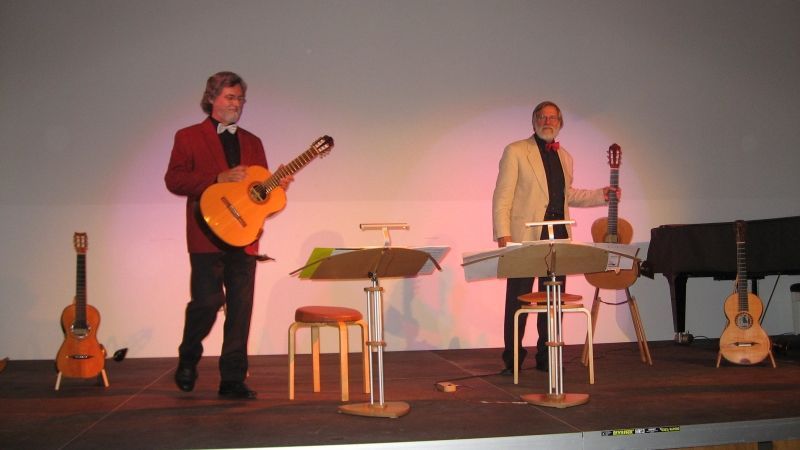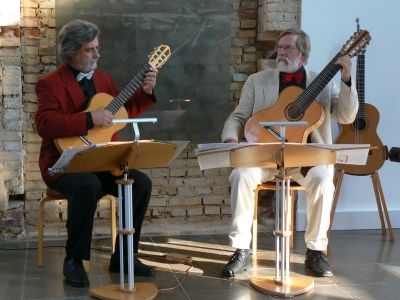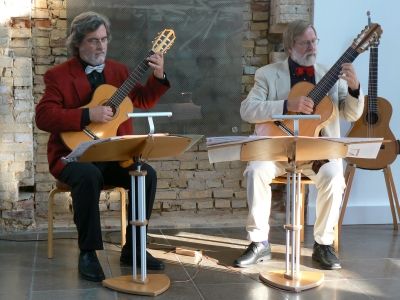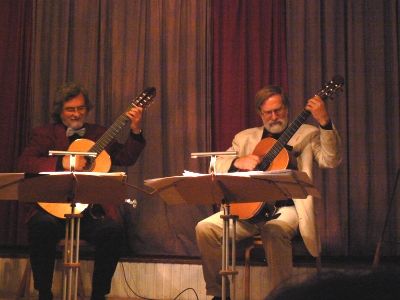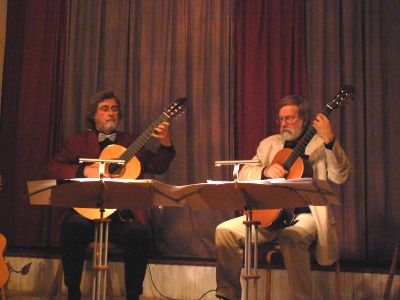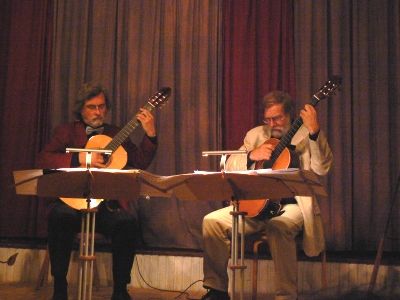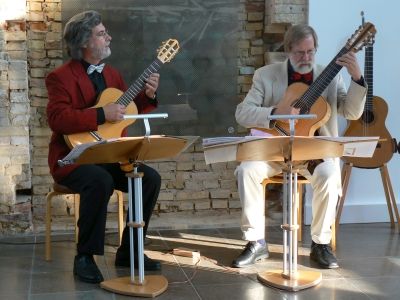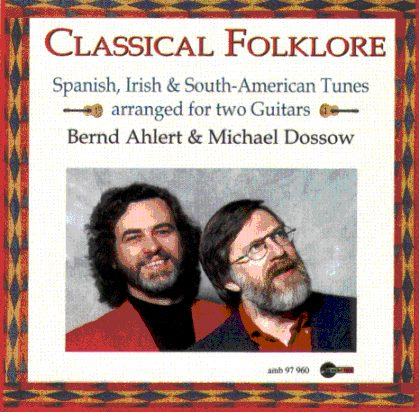|
Classical
Folklore
contiene música que
proviene de España, Sudamérica e Irlanda. La mayoría de las melodías y
bailes son de origen anónimo o en el caso de la música sudamericana son
clásicos o estándar, los cuales ya todos oyeron alguna vez. Dos
guitarristas de escuela clásica grabaron este CD y como se puede oír
fácilmente se divirtieron mucho.Oímos sonidos y ritmos, los cuales sin
rodeos van directos al corazón e incitan al movimiento. Entonces, qué
instrumento sería más apropiado para eso que la guitarra de folk llena
de vida?
Bernd Ahlert
nacido en 1952 y Michael Dossow en 1951, estudiaron música escolar
en Hamburgo y después se diplomaron como solistas en las Escuelas
Superiores de Música de Hamburgo y Bremen respectivamente. La
satisfacción de hacer música juntos, abrió las puertas para desarrollar
la concepción especial del concierto "La guitarra y su historia",
una serie de música de guitarra completada a través de textos,
ilustraciones, luz y accesorios. El trabajo con la música popular de
otros países ya empezó en los tiempos de estudiante y puso la primera
piedra para "Classical Folklore". Ahlert es actualmente
catedrático de guitarra en la "Hochschule für Musik" y en el
conservatorio de Hamburgo. Dossow dirige el departamento de música del
conservatorio de Hamburgo.
Len
(Leonard Arthur) Williams (1910-1987) hizo el arreglo de "Spanish
& South American Folk Songs". Originalmente pianista, Williams ya
fue con 14 años miembro de una banda profesional de música de baile.
Más tarde se dedicó a la guitarra de púa y a partir de 1946 se hizo un
nombre como guitarrista clásico. Para su hijo, el hoy mundialmente
conocido John Williams, él fue el primer profesor de guitarra.
El alegre "Boleras
Sevillanas" en dos partes, se distingue por el modificado ritmo
de bolero en la guitarra de acompañamiento, completada con una melodía
unísona. Esta pieza tranquila en sol-menor, que lleva el nombre de la
ciudad española Salamanca, se caracteriza por acordes de retardo y
un polifónico movimiento en la parte superior.
"El paño moruno",
se hizo en el animado compás de tres por ocho; unos acordes sincopados de
la primera guitarra, así como dinámicos contrastes y efectos pizzicato
de la segunda guitarra, le otorgan a la obra su típico carácter español
. La obra sudamericana de tres partes "El puerto", llama
la atención por su intensa armonía, que le da a la obra una cierta
amplitud y melancolía.
"Villancico"
nos muestra musicalmente que la fiesta de Navidad en España es más
alegre que meditabunda. En "Cantar Montañes" la
primera guitarra toca frases diferentes de seis, cinco y diez cadencias.
Sólo en la segunda parte se ordenan los hechos hacia arcos de melodía en
cuatro tiempos. Con eso, la guitarra de acompañamiento toca
fraccionamientos de acordes que siguen un ritmo constante . "Cubana",
una obra con una parte lenta en el medio , marcada por un ritmo pavano,
recibe su ímpetu por las partes rápidas de las esquinas. Con los
fraccionamientos de acordes de la primera guitarra, la segunda, toca un
acompañamiento rápido parecido al tango. En esta pieza se utilizan por
primera vez los instrumentos de percusión : Claves y maracas.
El compositor francés Jaques
Ibert (1890-1962), miembro de la academia francesa y director de la
Opéra National, escribió algunas composiciones para guitarra. Su estilo
es claramente influenciado por el Folk. Fácilmente se reconocen elementos
de la música española de guitarra en su obra "Paraboles".
El juego con diferentes acentuaciones del compás tres por cuatro, le
otorgan al primer tiempo - allegro moderato - su expresión. Unos rasgueos
enérgicos al principio y la subida de acordes al final lo encuadran. El
segundo tiempo empieza con unos encantadores armónicos pensativos y lleva
a través de unos cortos pasajes solistas en ambas guitarras, a un baile
final en cuatro por cuatro perdiéndose en la nada.
Los "Irish Tunes"
fueron adaptados por Bernd Ahlert para dos guitarras (o flauta y guitarra).
"Irish Washerwoman" (La lavandera de Irlanda), es un
clásico en el compás de una Double-Jig. La obra empieza lentamente y
aumenta con una variación de la primera parte hasta un carácter alegre
acelerado. "The Derry Air" (Melodía de Derry) la
conocemos también bajo el título "Danny Boy". Una primera
parte polifónica pasa poco a poco a un normal acompañamiento de acorde
de la segunda guitarra y al final añade a la melodía algunos efectos
armónicos extraordinarios. "Bob Jordan" es una
composición del arpista ciego Turlogh O’Carolan que vivió en
Irlanda desde 1670 hasta 1738 y cuya música fue editada por Edward
Bunting en Dublín en1798.
"Bob Jordan",
como sus otras dos obras de este CD "Carolan’s Concerto"
y "Planxty Johnston", representa una mezcla de música
vital popular de Irlanda con elementos de la música del barroco, en
particular con la música italiana de Corelli adorada por O’Carolan.
"The Foggy Dew" (El amanecer nublado) comienza con una
entrada de armónicos llena de atmósfera, extructurando el curso de la
pieza en interludio y coda. La segunda parte ofrece una variación del
curso de la melodía de la primera guitarra.
La última parte del CD -
"South American Tunes" con arreglo de B. Ahlert -
presenta piezas famosas sobre todo de Brasil. "Manha de Carnaval"
procede de la célebre película "Orfeu Negro". La pieza en
"tempo-di-Bolero", compuesta por Luiz Bonfa, fue
completada por el instrumento de percusión "egg-shaker". "Más
que nada" por Jorge Ben, brilla por su sincopado
acompañamiento de acordes y unos efectos de la primera guitarra,
enriquecidos por el instrumento de percusión Ganzá. "Bésame
mucho" por Consuelo Velazquez, una pieza famosa en el
ritmo Beguine, obtiene su carácter lascivo por la baja tesitura de la
primera guitarra. Unos bongos le dan a la pieza el apoyo rítmico. Con
"Brasil" de Ary Baroso, viene finalmente una Samba
brasileña, acompañada por los instrumentos de ritmo Pandeiro y Tamborim,
típicos para esta música. "Cariña" fue escrita
originalmente como rumba para dos guitarras de Jazz en 1937 por el
americano Johnny Cali. Numerosas síncopas y un contraste en modo
mayor caracterizan esta pieza; los timbales complementan a las guitarras.
"Morenita do Brasil",
compuesto como dúo de guitarra por Giuseppe Farrauto, obtuvo un
nuevo arreglo por B. Ahlert para un bajo acústico, dos guitarras y una
guitarra en la octava.
Bernd Ahlert
Traducción: Nardo
González
|
